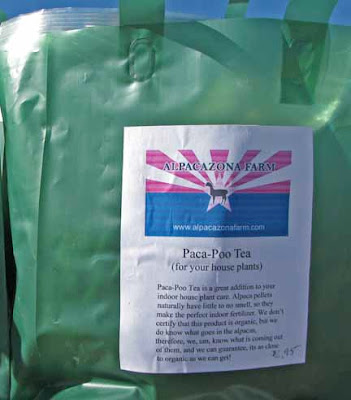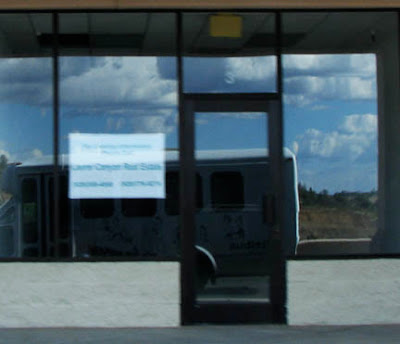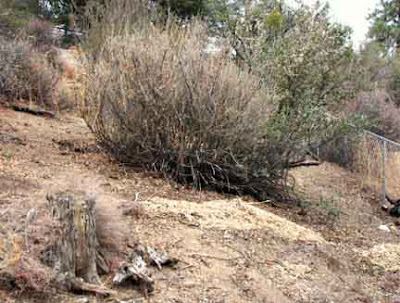Long, long ago, when I had a one mile walk to the little Chicago neighborhood weekly I edited, no matter what the weather, I bought the coziest, warmest coat I've ever owned. It was reasonably priced, too. Something like twenty-five or thirty-five bucks. Wool on the outside, a fuzzy alpaca lining on the inside. And not sold as a luxury item, either -- straight off the racks at Wiebolt's, a low-end department store. Today, alpaca remains quite as warm, but it can be somewhat pricey.

This was the weekend of the Alpaca Holiday Boutique, way out in Chino Valley. Oh, I wanted to go so badly and so begged friends to drive the lot of us out to the event (begging -- that's the price one pays for being a non-driver). And so I thank
sheoflittlebrain of
The One Acre Wood for a wonderful outing at the
Singletree Farm where five local alpaca farmers were displaying their wares. A Christmas tradition, I guess, because I've seen the sales advertised for several years now.


There were hats and scarves and gloves and sox and plenty of beautiful yarns.



Not to mention a drop-dead-gorgeous sweater. Another nostalgia trigger, that. Back in the day when I still indulged in needlework, I came into some brown alpaca yarn for which I designed a raglan-sleeve sweater knit in the round. The body was all purl; the feature was a 4-stitch cable where the raglan "seam" would normally appear. It was a very pretty garment, but there was one big problem -- there were few places I could wear it, as it was so very, very warm.

Another feature of the boutique: spinners working with the yummy fibers. And, below, one more product of the alpaca farm: camelid poo, recommended for fertilizing indoor plants.


But there was more than just the boutique -- we got to meet the source of the fiber goodies, gathered around the farmer who was passing out carrots. Look at all those beautiful natural colors on the hoof. BTW, the cute little guy in the upper and lower picture is almost all of three weeks old! As
Wikipedia tells it,
alpacas have been domesticated for thousands of years. There are no wild alpacas. The closest living species are the wild vicuña, also native to South America. Along with camels and llamas, the alpaca are classified as camelids. The alpaca is larger than the vicuña but smaller than the other camelid species. Of the various camelid species, the alpaca and vicuña are the most valuable fiber-bearing animals: the alpaca because of the quality and quantity of its fiber and the vicuña because of the softness, fineness and quality of its coat. Alpacas are too small to be used as pack animals; instead, they were bred exclusively for their fiber and meat.


After reading the Wikipedia article, I finally realize why those alpaca garments were so warm: the creatures normally graze at an altitude of 3,500 m (11,483 ft) to 5,000 m (16,404 ft) meters above sea-level. Yikes! Those are elevations at which I wouldn't survive! Even though the local animals are sheared each year in May, I'm surprised they survive through our summers. More info: there are six alpaca farmers in Chino and a total of ten in the greater Prescott area.
 Note: this post is dedicated to my SIL, who has longed for a llama of his very own for as long as I've known him
Note: this post is dedicated to my SIL, who has longed for a llama of his very own for as long as I've known him.
 This was the weekend of the Alpaca Holiday Boutique, way out in Chino Valley. Oh, I wanted to go so badly and so begged friends to drive the lot of us out to the event (begging -- that's the price one pays for being a non-driver). And so I thank sheoflittlebrain of The One Acre Wood for a wonderful outing at the Singletree Farm where five local alpaca farmers were displaying their wares. A Christmas tradition, I guess, because I've seen the sales advertised for several years now.
This was the weekend of the Alpaca Holiday Boutique, way out in Chino Valley. Oh, I wanted to go so badly and so begged friends to drive the lot of us out to the event (begging -- that's the price one pays for being a non-driver). And so I thank sheoflittlebrain of The One Acre Wood for a wonderful outing at the Singletree Farm where five local alpaca farmers were displaying their wares. A Christmas tradition, I guess, because I've seen the sales advertised for several years now.
 There were hats and scarves and gloves and sox and plenty of beautiful yarns.
There were hats and scarves and gloves and sox and plenty of beautiful yarns.

 Not to mention a drop-dead-gorgeous sweater. Another nostalgia trigger, that. Back in the day when I still indulged in needlework, I came into some brown alpaca yarn for which I designed a raglan-sleeve sweater knit in the round. The body was all purl; the feature was a 4-stitch cable where the raglan "seam" would normally appear. It was a very pretty garment, but there was one big problem -- there were few places I could wear it, as it was so very, very warm.
Not to mention a drop-dead-gorgeous sweater. Another nostalgia trigger, that. Back in the day when I still indulged in needlework, I came into some brown alpaca yarn for which I designed a raglan-sleeve sweater knit in the round. The body was all purl; the feature was a 4-stitch cable where the raglan "seam" would normally appear. It was a very pretty garment, but there was one big problem -- there were few places I could wear it, as it was so very, very warm. Another feature of the boutique: spinners working with the yummy fibers. And, below, one more product of the alpaca farm: camelid poo, recommended for fertilizing indoor plants.
Another feature of the boutique: spinners working with the yummy fibers. And, below, one more product of the alpaca farm: camelid poo, recommended for fertilizing indoor plants.
 But there was more than just the boutique -- we got to meet the source of the fiber goodies, gathered around the farmer who was passing out carrots. Look at all those beautiful natural colors on the hoof. BTW, the cute little guy in the upper and lower picture is almost all of three weeks old! As Wikipedia tells it, alpacas have been domesticated for thousands of years. There are no wild alpacas. The closest living species are the wild vicuña, also native to South America. Along with camels and llamas, the alpaca are classified as camelids. The alpaca is larger than the vicuña but smaller than the other camelid species. Of the various camelid species, the alpaca and vicuña are the most valuable fiber-bearing animals: the alpaca because of the quality and quantity of its fiber and the vicuña because of the softness, fineness and quality of its coat. Alpacas are too small to be used as pack animals; instead, they were bred exclusively for their fiber and meat.
But there was more than just the boutique -- we got to meet the source of the fiber goodies, gathered around the farmer who was passing out carrots. Look at all those beautiful natural colors on the hoof. BTW, the cute little guy in the upper and lower picture is almost all of three weeks old! As Wikipedia tells it, alpacas have been domesticated for thousands of years. There are no wild alpacas. The closest living species are the wild vicuña, also native to South America. Along with camels and llamas, the alpaca are classified as camelids. The alpaca is larger than the vicuña but smaller than the other camelid species. Of the various camelid species, the alpaca and vicuña are the most valuable fiber-bearing animals: the alpaca because of the quality and quantity of its fiber and the vicuña because of the softness, fineness and quality of its coat. Alpacas are too small to be used as pack animals; instead, they were bred exclusively for their fiber and meat.
 After reading the Wikipedia article, I finally realize why those alpaca garments were so warm: the creatures normally graze at an altitude of 3,500 m (11,483 ft) to 5,000 m (16,404 ft) meters above sea-level. Yikes! Those are elevations at which I wouldn't survive! Even though the local animals are sheared each year in May, I'm surprised they survive through our summers. More info: there are six alpaca farmers in Chino and a total of ten in the greater Prescott area.
After reading the Wikipedia article, I finally realize why those alpaca garments were so warm: the creatures normally graze at an altitude of 3,500 m (11,483 ft) to 5,000 m (16,404 ft) meters above sea-level. Yikes! Those are elevations at which I wouldn't survive! Even though the local animals are sheared each year in May, I'm surprised they survive through our summers. More info: there are six alpaca farmers in Chino and a total of ten in the greater Prescott area. Note: this post is dedicated to my SIL, who has longed for a llama of his very own for as long as I've known him.
Note: this post is dedicated to my SIL, who has longed for a llama of his very own for as long as I've known him.










































